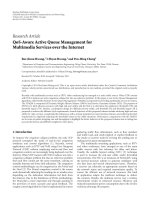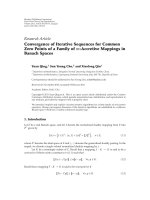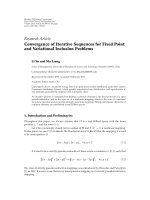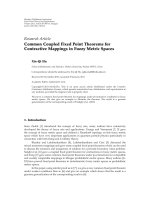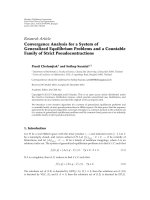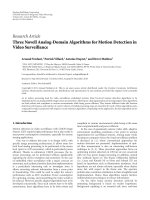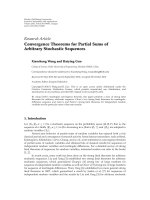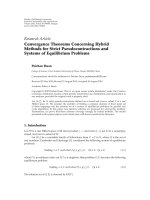Báo cáo hóa học: " Research Article Convergence on Composite Iterative Schemes for Nonexpansive Mappings in Banach Spaces" potx
Bạn đang xem bản rút gọn của tài liệu. Xem và tải ngay bản đầy đủ của tài liệu tại đây (525.72 KB, 14 trang )
Hindawi Publishing Corporation
Fixed Point Theory and Applications
Volume 2008, Article ID 167535, 14 pages
doi:10.1155/2008/167535
Research Article
Convergence on Composite Iterative Schemes for
Nonexpansive Mappings in Banach Spaces
Jong Soo Jung
Department of Mathematics, Dong-A University, Busan 604-714, South Korea
Correspondence should be addressed to Jong Soo Jung,
Received 13 January 2008; Revised 5 April 2008; Accepted 3 May 2008
Recommended by Mohammed Khamsi
Let E be a reflexive Banach space with a uniformly G
ˆ
ateaux differentiable norm. Suppose that every
weakly compact convex subset of E has the fixed point property for nonexpansive mappings. Let C
be a nonempty closed convex subset of E, f : C → C a contractive mapping or a weakly contractive
mapping,andT : C → C nonexpansive mapping with the fixed point set FT
/
∅.Let{x
n
} be
generated by a new composite iterative scheme: y
n
λ
n
fx
n
1−λ
n
Tx
n
, x
n1
1−β
n
y
n
β
n
Ty
n
,
n ≥ 0.Itisprovedthat{x
n
} converges strongly to a point in FT, which is a solution of
certain variational inequality provided that the sequence {λ
n
}⊂0, 1 satisfies lim
n→∞
λ
n
0and
∞
n1
λ
n
∞, {β
n
}⊂0,a for some 0 <a<1 and the sequence {x
n
} is asymptotically regular.
Copyright q 2008 Jong Soo Jung. This is an open access article distributed under the Creative
Commons Attribution License, which permits unrestricted use, distribution, and reproduction in
any medium, provided the original work is properly cited.
1. Introduction
Let E be a real Banach space and let C be a nonempty closed convex subset of E.Recallthata
mapping f : C → C is a contraction on C if there exists a constant k ∈ 0, 1 such that fx −
fy≤kx − y,x,y∈ C. We use Σ
C
to denote the collection of mappings f verifying the
above inequality. That is, Σ
C
{f : C → C | f is a contraction with constant k}. Note that each
f ∈ Σ
C
has a unique fixed point in C.
Now let T : C → C be a nonexpansive mapping recall that a mapping T : C → C is
nonexpansive if Tx − Ty≤x − y,x,y∈ C and FT denote the set of fixed points of T;that
is, FT{x ∈ C : x Tx}.
We consider the iterative scheme: for T nonexpansive mapping, f ∈ Σ
C
and λ
n
∈ 0, 1,
x
n1
λ
n
f
x
n
1 − λ
n
Tx
n
,n≥ 0. 1.1
As a special case of 1.1, the following iterative scheme:
z
n1
λ
n
u
1 − λ
n
Tz
n
,n≥ 0, 1.2
2 Fixed Point Theory and Applications
where u, z
0
∈ C are arbitrary but fixed, has been investigated by many authors; see, for
example, Cho et al. 1, Halpern 2,Lions3,Reich4, 5, Shioji and Takahashi 6, Wittmann
7,andXu8. The authors above showed that the sequence {z
n
} generated by 1.2 converges
strongly to a point in the fixed point set FT under appropriate conditions on {λ
n
} in either
Hilbert spaces or certain Banach spaces. Recently, many authors also considered the iterative
scheme 1.2 for finite or countable families of nonexpansive mappings {T
i
}
i∈{1,2, ,r or∞}
; see,
for instance, 9–14.
The viscosity approximation method of selecting a particular fixed point of a given
nonexpansive mapping in a Hilbert space was proposed by Moudafi 15see 16 for finding
hierarchically a fixed point. In 2004, Xu 17 extended Theorem 2.2 of Moudafi 15 for the
iterative scheme 1.1 to a Banach space setting using the following conditions on {λ
n
}:
H1 lim
n→∞
λ
n
0;
∞
n0
λ
n
∞ or, equivalently,
∞
n0
1 − λ
n
0;
H2
∞
n0
|λ
n1
− λ
n
| < ∞ or lim
n→∞
λ
n
/λ
n1
1.
We also refer to 18–23 for the iterative scheme 1.1 for finite of countable families of
nonexpansive mappings {T
i
}
i∈{1,2, ,r or ∞}
. For the iterative scheme 1.1 with generalized
contractive mappings instead of contractions, see 22, 24.Wecanreferto25 for the general
iteration method for finding a zero of accretive operator.
Recently, Kim and Xu 26 provided a simpler modification of Mann iterative scheme
1.3 in a uniformly smooth Banach space as follows:
x
0
x ∈ C,
y
n
β
n
x
n
1 − β
n
Tx
n
,
x
n1
α
n
u
1 − α
n
y
n
,
1.3
where u ∈ C is an arbitrary but fixed element, and {α
n
} and {β
n
} are two sequences in 0, 1.
They proved that {x
n
} generated by 1.3 converges to a fixed point of T under the control
conditions:
i lim
n→∞
α
n
0, lim
n→∞
β
n
0;
ii
∞
n0
α
n
∞, or equivalently,
∞
n0
1 − α
n
0,
∞
n0
β
n
∞;
iii
∞
n0
|α
n1
− α
n
| < ∞,
∞
n0
|β
n1
− β
n
| < ∞.
In this paper, motivated by the above-mentioned results, as the viscosity approximation
method, we consider a new composite iterative scheme for nonexpansive mapping T:
x
0
x ∈ C,
y
n
λ
n
f
x
n
1 − λ
n
Tx
n
,
x
n1
1 − β
n
y
n
β
n
Ty
n
,
IS
where {β
n
}, {λ
n
}⊂0, 1. First, we prove the strong convergence of the sequence {x
n
}
generated by IS under the suitable conditions on the control parameters {β
n
} and {λ
n
}
and the asymptotic regularity on {x
n
} in reflexive Banach space with a uniformly G
ˆ
ateaux
differentiable norm together with the assumption that every weakly compact convex subset of
E has the fixed point property for nonexpansive mappings. Moreover, we show that the strong
Jong Soo Jung 3
limit is a solution of certain variational inequality. Next, we study the viscosity approximation
with the weakly contractive mapping to a fixed point of nonexpansive mapping in the same
Banach space. The main results improve and complement the corresponding results of 1–
8, 15, 17. In particular, if β
n
0, for all n ≥ 0, then IS reduces to 1.1. We point out that the
iterative scheme IS is a new one for finding a fixed point of T.
2. Preliminaries and lemmas
Let E be a real Banach space with norm · and let E
∗
be its dual. The value of f ∈ E
∗
at x ∈ E
will be denoted by x, f. When {x
n
} is a sequence in E,thenx
n
→ x resp., x
n
x will
denote strong resp., weak convergence of the sequence {x
n
} to x.
The normalized duality mapping J from E into the family of nonempty by Hahn-Banach
theorem weak-star compact subsets of its dual E
∗
is defined by
Jx
f ∈ E
∗
: x, f x
2
f
2
2.1
for each x ∈ E 27.
The norm of E is said to be G
ˆ
ateaux differentiable and E is said to be smooth if
lim
t→0
x ty−x
t
2.2
exists for each x, y in its unit sphere U {x ∈ E : x 1}. The norm is said to be uniformly
G
ˆ
ateaux differentiable if for y ∈ U, the limit is attained uniformly for x ∈ U. The space E is said
to have a uniformly Fr
´
echet differentiable norm and E is said to be uniformly smooth if the limit
in 2.2 is attained uniformly for x, y ∈ U × U.ItisknownthatE is smooth if and only if each
duality mapping J is single-valued. It is also well known that if E has a uniformly G
ˆ
ateaux
differentiable norm, J is uniformly norm to weak continuous on each bounded subset of E
27.
Let C be a nonempty closed convex subset of E. C is said to have the fixed point property
for nonexpansive mappings if every nonexpansive mapping of a bounded closed convex
subset D of C has a fixed point in D.
Let D
be a subset of C. Then, a mapping Q : C → D is said to be a retraction from C onto
D if Qx x for all x ∈ D. A retraction Q : C → D is said to be sunny if QQx tx − Qx Qx
for all x ∈ C and t ≥ 0withQxtx−Qx ∈ C. A subset D of C is said to be a sunny nonexpansive
retract of C if there exists a sunny nonexpansive retraction of C onto D. In a smooth Banach
space E,itiswellknown28, page 48 that Q is a sunny nonexpansive retraction from C onto
D if and only if the following condition h olds:
x − Qx, Jz − Qx
≤ 0,x∈ C, z
∈ D. 2.3
We need the following lemmas for the proof of our main results. Lemma 2.1 was also
given by Jung and Morales 29 and Lemma 2.2 is essentially Lemma 2 of Liu 30also see
8.
Lemma 2.1. Let X be a real Banach space and let J be the duality mapping. Then, for any given x,y ∈
X, one has
x y
2
≤x
2
2
y, jx y
2.4
for all jx y ∈ Jx y.
4 Fixed Point Theory and Applications
Lemma 2.2. Let {s
n
} be a sequence of nonnegative real numbers satisfying
s
n1
≤ 1 − α
n
s
n
α
n
γ
n
δ
n
,n≥ 0, 2.5
where {α
n
}, {γ
n
}, and {δ
n
} satisfy the following conditions:
i {α
n
}⊂0, 1 and
∞
n0
α
n
∞ or, equivalently,
∞
n0
1 − α
n
0,
ii lim sup
n→∞
γ
n
≤ 0 or
∞
n1
α
n
γ
n
< ∞,
iii δ
n
≥ 0 n ≥ 0,
∞
n0
δ
n
< ∞.
Then, lim
n→∞
s
n
0.
Recall that a mapping A : C → C is said to be weakly contractive if
Ax − Ay≤x − y−ψ
x − y
, ∀x, y ∈ C, 2.6
where ψ : 0, ∞ → 0, ∞ is a continuous and strictly increasing function such that ψ is
positive on 0, ∞ and ψ00. As a special case, if ψt1 − kt for t ∈ 0, ∞,where
k ∈ 0, 1, then the weakly contractive mapping A is a contraction with constant k. Rhoades
31
obtained the following result for weakly contractive mapping.
Lemma 2.3 see 31,Theorem2. Let X, d be a complete metric space, and A a weakly contractive
mapping on X.Then,A has a unique fixed point p in X. Moreover, for x ∈ X, {A
n
x} converges strongly
to p.
The following lemma was given in 32, 33.
Lemma 2.4. Let {s
n
} and {γ
n
} be two sequences of nonnegative real numbers and {λ
n
} a sequence of
positive numbers satisfying the conditions
i
∞
n0
λ
n
∞ or, equivalently,
∞
n0
1 − λ
n
0,
ii lim
n→∞
γ
n
/λ
n
0.
Let the recursive inequality
s
n1
≤ s
n
− λ
n
ψ
s
n
γ
n
,n 0, 1, 2, , 2.7
be given where ψt is a continuous and strict increasing function on 0, ∞ with ψ00.Then,
lim
n→∞
s
n
0.
Finally, the sequence {x
n
} in E is said to be asymptotically regular if
lim
n→∞
x
n1
− x
n
0. 2.8
3. Main results
First, using the asymptotic regularity, we study a strong convergence theorem for a composite
iterative scheme for the nonexpansive mapping with the contractive mapping.
Jong Soo Jung 5
For T : C → C nonexpansive and so for any t ∈ 0, 1 and f ∈ Σ
C
, tf 1 − tT : C → C
defines a strict contraction mapping. Thus, by the Banach contraction mapping principle, there
exists a unique fixed point x
f
t
satisfying
x
f
t
tf
x
f
t
1 − tTx
f
t
. R
For simplicity, we will write x
t
for x
f
t
provided no confusion occurs.
In 2006, the following result was given by Jung 18see also Xu 17 for the result in
uniformly smooth Banach spaces.
Theorem J see Jung 18. Let E be a reflexive Banach space with a uniformly G
ˆ
ateaux differentiable
norm. Suppose that every weakly compact convex subset of E has the fixed point property for
nonexpansive mappings. Let C be a nonempty closed convex subset of E and T nonexpansive mapping
from C into itself with FT
/
∅.Then,{x
t
} defined by R converges strongly to a point in FT.If
one defines Q : Σ
C
→ FT by
Qf : lim
t→0
x
t
,f∈ Σ
C
, 3.1
then Qf solves a variational inequality
I − f
Qf
,J
Qf − p
≤ 0,f∈ Σ
C
,p∈ FT. 3.2
Remark 3.1. In Theorem J, if fxu ∈ C is a constant, then 3.2 becomes
Qu − u, J
Qu − p
≤ 0,u∈ C, p ∈ FT. 3.3
Hence by 2.3, Q reduces to the sunny nonexpansive retraction from C to FT. Namely, FT
is a sunny nonexpansive retraction of C.
Using Theorem J and the asymptotic regularity on the sequence {x
n
},wehavethe
following result.
Theorem 3.2. Let E be a reflexive Banach space with a uniformly G
ˆ
ateaux differentiable norm. Suppose
that every weakly compact convex subset of E has the fixed point property for nonexpansive mappings.
Let C be a nonempty closed convex subset of E and T nonexpansive mappings from C into itself with
FT
/
∅.Let{β
n
} and {λ
n
} be sequences in 0, 1 which satisfies the conditions:
B1 β
n
∈ 0,a for some 0 <a<1 for all n ≥ 0,
C1 lim
n→∞
λ
n
0;
∞
n0
λ
n
∞.
Let f ∈ Σ
C
and x
0
∈ C be chosen arbitrarily. Let {x
n
} be the sequence generated by
x
0
x ∈ C,
y
n
λ
n
f
x
n
1 − λ
n
Tx
n
,
x
n1
1 − β
n
y
n
β
n
Ty
n
,n≥ 0.
IS
If {x
n
} is asymptotically regular, then {x
n
} converges strongly to Qf ∈ FT,whereQf is the
unique solution of the variational inequality
I − f
Qf
,J
Qf − p
≤ 0,f∈ Σ
C
,p∈ FT. 3.4
6 Fixed Point Theory and Applications
Proof. We notice that by Theorem J, there exists a solution Qf of a variational inequality
I − f
Qf
,J
Qf − p
≤ 0,f∈ Σ
C
,p∈ FT. 3.5
Namely, Qflim
t→0
x
t
,wherex
t
is defined by R. We will show that x
n
→ Qf.
We proceed with the following steps.
Step 1. We show that x
n
−z≤max{x
0
−z, 1/1−kfz−z} for all n ≥ 0andallz ∈ FT
and so {x
n
}, {y
n
}, {fx
n
}, {Tx
n
}, and {Ty
n
} are bounded.
Indeed, let z ∈ FT. Then, we have
y
n
− z
λ
n
f
x
n
− z
1 − λ
n
Tx
n
− z
≤ λ
n
f
x
n
− z
1 − λ
n
x
n
− z
≤ λ
n
f
x
n
− fz
fz − z
1 − λ
n
x
n
− z
≤ λ
n
k
x
n
− z
λ
n
fz − z
1 − λ
n
x
n
− z
1 −
1 − kλ
n
x
n
− z
λ
n
fz − z
≤ max
x
n
− z
,
1
1 − k
fz − z
,
x
n1
− z
1 − β
n
y
n
− z
β
n
Ty
n
− z
≤
1 − β
n
y
n
− z
β
n
y
n
− z
y
n
− z
≤ max
x
n
− z
,
1
1 − k
fz − z
.
3.6
Using an induction, we obtain
x
n
− z
≤ max
x
0
− z
,
1
1 − k
fz − z
3.7
for all n ≥ 0. Hence, {x
n
} is bounded, and so are {y
n
}, {Tx
n
}, {Ty
n
}, and {fx
n
}. Moreover, it
follows from condition C1 that
y
n
− Tx
n
λ
n
f
x
n
− Tx
n
−→ 0 as n −→ ∞ . 3.8
Step 2. We show that lim
n →∞
x
n1
− y
n
0 and lim
n→∞
x
n
− y
n
0. Indeed, by the condition
B1
x
n1
− y
n
β
n
Ty
n
− y
n
≤ β
n
Ty
n
− Tx
n
Tx
n
− y
n
≤ a
y
n
− x
n
Tx
n
− y
n
≤ a
y
n
− x
n1
x
n1
− x
n
Tx
n
− y
n
3.9
which implies that
x
n1
− y
n
≤
a
1 − a
x
n1
− x
n
Tx
n
− y
n
. 3.10
Jong Soo Jung 7
So, by asymptotic regularity of {x
n
} and 3.8,wehavex
n1
− y
n
→0, and also
x
n
− y
n
≤
x
n
− x
n1
x
n1
− y
n
−→ 0 as n −→ ∞ . 3.11
Step 3. We show that lim
n→∞
y
n
− Ty
n
0. By 3.8 and Step 2,wehave
y
n
− Ty
n
≤
y
n
− Tx
n
Tx
n
− Ty
n
≤
y
n
− Tx
n
x
n
− y
n
−→ 0.
3.12
Step 4. We show that lim sup
n→∞
Qf − fQf,JQf − y
n
≤0. To prove this, let a
subsequence {y
n
j
} of {y
n
} be such that
lim sup
n→∞
Qf − f
Qf
,J
Qf − y
n
lim
j→∞
Qf − f
Qf
,J
Qf − y
n
j
3.13
and y
n
j
pfor some p ∈ E. From Step 3, it follows that lim
j→∞
y
n
j
− Ty
n
j
0.
Now let Qflim
t→0
x
t
,wherex
t
tfx
t
1 − tTx
t
. Then, we can write
x
t
− y
n
j
t
f
x
t
− y
n
j
1 − t
Tx
t
− y
n
j
. 3.14
Putting
a
j
t1 − t
2
Ty
n
j
− y
n
j
2
x
t
− y
n
j
Ty
n
j
− y
n
j
−→ 0 j −→ ∞ 3.15
by Step 3 and using Lemma 2.1,weobtain
x
t
− y
n
j
2
≤ 1 − t
2
Tx
t
− y
n
j
2
2t
f
x
t
− y
n
j
,J
x
t
− y
n
j
≤ 1 − t
2
Tx
t
− Ty
n
j
Ty
n
j
− y
n
j
2
2t
f
x
t
− x
t
,J
x
t
− y
n
j
2tx
t
− y
n
j
2
≤ 1 − t
2
x
t
− y
n
j
2
a
j
t2t
f
x
t
− x
t
,J
x
t
− y
n
j
2tx
t
− y
n
j
2
.
3.16
The last inequality implies
x
t
− f
x
t
,J
x
t
− y
n
j
≤
t
2
x
t
− y
n
j
2
1
2t
a
j
t. 3.17
It follows that
lim sup
j→∞
x
t
− f
x
t
,J
x
t
− y
n
j
≤
t
2
M, 3.18
where M>0 is a constant such that M ≥x
t
− y
n
2
for all n ≥ 0andt ∈ 0, 1.Takingthe
lim sup as t → 0in3.18 and noticing the fact that the two limits are interchangeable due to
the fact that J is uniformly continuous on bounded subsets of E from the strong topology of E
to the weak
∗
topology of E
∗
,wehave
lim sup
j→∞
Qf − f
Qf
,J
Qf − y
n
j
≤ 0. 3.19
8 Fixed Point Theory and Applications
Indeed, letting t → 0, from 3.18 we have
lim sup
t→0
lim sup
j→∞
x
t
− f
x
t
,J
x
t
− y
n
j
≤ 0. 3.20
So, for any ε>0, there exists a positive n umber δ
1
such that for any t ∈ 0,δ
1
,
lim sup
j→∞
x
t
− f
x
t
,J
x
t
− y
n
j
≤
ε
2
. 3.21
Moreover, since x
t
→ Qf as t → 0, the set {x
t
− y
n
j
} is bounded and the duality mapping J
is norm-to-weak
∗
uniformly continuous on bounded subset of E, there exists δ
2
> 0 such that,
for any t ∈ 0,δ
2
,
Qf − f
Qf
,J
Qf − y
n
j
−
x
t
− f
x
t
,J
x
t
− y
n
j
Qf − f
Qf
,J
Qf − y
n
j
− J
x
t
− y
n
j
Qf − f
Qf
−
x
t
− f
x
t
,J
x
t
− y
n
j
≤
Qf − f
Qf
,J
x
t
− y
n
j
− J
Qf − y
n
j
Qf − f
Qf
−
x
t
− f
x
t
x
t
− y
n
j
<
ε
2
.
3.22
Choose δ min{δ
1
,δ
2
}, we have for all t ∈ 0,δ and j ∈ N,
Qf − f
Qf
,J
Qf − y
n
j
<
x
t
− f
x
t
,J
x
t
− y
n
j
ε
2
, 3.23
which implies that
lim sup
j→∞
Qf − f
Qf
,J
Qf − y
n
j
≤ lim sup
j→∞
x
t
− f
x
t
,J
x
t
− y
n
j
ε
2
. 3.24
Since lim sup
j→∞
x
t
− fx
t
,Jx
t
− y
n
j
≤ε/2, we have
lim sup
j→∞
Qf − f
Qf
,J
Qf − y
n
j
≤ ε. 3.25
Since ε is arbitrary, we obtain that
lim sup
j→∞
Qf − f
Qf
,J
Qf − y
n
j
≤ 0. 3.26
Step 5. We show that lim
n→∞
x
n
− Qf 0. By using IS,wehave
x
n1
− Qf
≤
y
n
− Qf
λ
n
f
x
n
− Qf
1 − λ
n
Tx
n
− Qf
. 3.27
Jong Soo Jung 9
Applying Lemma 2.1,weobtain
x
n1
− Qf
2
≤
y
n
− Qf
2
≤
1 − λ
n
2
Tx
n
− Qf
2
2λ
n
f
x
n
− Qf,J
y
n
− Qf
≤
1 − λ
n
2
x
n
− Qf
2
2λ
n
f
x
n
− f
Qf
,J
y
n
− Qf
2λ
n
f
Qf
− Qf,J
y
n
− Qf
≤
1 − λ
n
2
x
n
− Qf
2
2kλ
n
x
n
− Qf
y
n
− Qf
2λ
n
f
Qf
− Qf,J
y
n
− Qf
≤
1 − λ
n
2
x
n
− Qf
2
2kλ
n
x
n
− Qf
2
2λ
n
f
Qf
− Qf,J
y
n
− Qf
.
3.28
It then follows that
x
n1
− Qf
2
≤
1 − 21 − kλ
n
λ
2
n
x
n
− Qf
2
2λ
n
Qf − f
Qf
,J
Qf − y
n
≤
1 − 2 − kλ
n
x
n
− Qf
2
λ
2
n
M
2
2λ
n
Qf − f
Qf
,J
Qf − y
n
,
3.29
where M sup
n≥0
x
n
− Qf.Put
α
n
21 − kλ
n
,
γ
n
λ
n
21 − k
M
2
1
1 − k
Qf − f
Qf
,J
Qf − y
n
.
3.30
From the condition C1 and Step 4, it follows that α
n
→ 0,
∞
n0
α
n
∞, and lim sup
n→∞
γ
n
≤ 0.
Since 3.29 reduces to
x
n1
− Qf
2
≤ 1 − α
n
x
n
− Qf
2
α
n
γ
n
, 3.31
from Lemma 2.2 with δ
n
0, we conclude that lim
n→∞
x
n
− Qf 0. This completes the
proof.
Corollary 3.3. Let E be a uniformly smooth Banach space. Let C, T, f, {β
n
}, {λ
n
},f,x
0
,and{x
n
} be
thesameasinTheorem 3.2. Then, the conclusion of Theorem 3.2 still holds.
Proof. Since E is a uniformly smooth Banach space, E is reflexive and the norm is uniformly
G
ˆ
ateaux differentiable norm and its every nonempty weakly compact convex subset of E has
the fixed point property for nonexpansive mappings. Thus, the conclusion of Corollary 3.3
follows from Theorem 3.2 immediately.
10 Fixed Point Theory and Applications
Remark 3.4. 1 If {β
n
} and {λ
n
} in Theorem 3.2 satisfy the conditions
B2
∞
n0
|β
n1
− β
n
| < ∞,
C1 lim
n→∞
λ
n
0,
∞
n0
λ
n
∞,
C2
∞
n0
|λ
n1
− λ
n
| < ∞,or
C3 lim
n→∞
λ
n
/λ
n1
1, or
C4 |λ
n1
− λ
n
|≤◦λ
n1
σ
n
,
∞
n0
σ
n
< ∞ the perturbed control condition,
then the sequence {x
n
} generated by IS is asymptotically regular. Now, we only give the
proof in case when {β
n
} and {λ
n
} satisfy the conditions B2, C1,andC4.Indeed,fromIS,
we have for every n ≥ 1,
y
n
λ
n
f
x
n
1 − λ
n
Tx
n
,
y
n−1
λ
n−1
f
x
n−1
1 − λ
n−1
Tx
n−1
,
3.32
and so, for every n ≥ 1, we have
y
n
− y
n−1
1 − λ
n
Tx
n
− Tx
n−1
λ
n
f
x
n
− f
x
n−1
λ
n
− λ
n−1
f
x
n−1
− Tx
n−1
≤
1 − λ
n
x
n
− x
n−1
L
λ
n
− λ
n−1
kλ
n
x
n
− x
n−1
1 − 1 − kλ
n
x
n
− x
n−1
L
λ
n
− λ
n−1
,
3.33
where L sup{fx
n
− Tx
n
: n ≥ 0}.
On the other hand, by IS,wealsohaveforeveryn ≥ 1,
x
n1
1 − β
n
y
n
β
n
Ty
n
,
x
n
1 − β
n−1
y
n−1
β
n−1
Ty
n−1
.
3.34
Simple calculations show that
x
n1
− x
n
1 − β
n
y
n
− y
n−1
β
n
Ty
n
− Ty
n−1
β
n
− β
n−1
Ty
n−1
− y
n−1
,
3.35
then it follows that
x
n1
− x
n
≤
1 − β
n
y
n
− y
n−1
β
n
y
n
− y
n−1
β
n
− β
n−1
Ty
n−1
− y
n−1
.
3.36
Substituting 3.33 into 3.36 and using the condition C4,wederive
x
n1
− x
n
≤
1 − 1 − kλ
n
x
n
− x
n−1
L
λ
n
− λ
n−1
M
β
n
− β
n−1
≤
1 − 1 − kλ
n
x
n
− x
n−1
L
◦
λ
n
σ
n−1
M
β
n
− β
n−1
,
3.37
where M sup{Ty
n
− y
n
: n ≥ 0}.Bytakings
n1
x
n1
− x
n
, α
n
1 − kλ
n
, α
n
γ
n
L◦ λ
n
,
and δ
n
Lσ
n−1
M|β
n
− β
n−1
|,wehave
s
n1
≤
1 − α
n
s
n
α
n
γ
n
δ
n
. 3.38
Jong Soo Jung 11
Hence, by the conditions B2, C1,andC4 and Lemma 2.2, lim
n→∞
x
n1
−x
n
0. Moreover,
from 3.33 and the condition C4, it follows that lim
n→∞
y
n
− y
n−1
0.
2 The control conditions C2 and C3 are not comparable coupled w ith condition
C1, that is, neither of them implies the others. For this fact, see 13, 34. We also refer to 13
for the examples which satisfy condition C1 and the perturbed control condition C4 but fail
to satisfy both conditions C2 and C3. See also 1.
From these facts in Remark 3.4, we have the following.
Corollary 3.5. Let E, C, and T be the same as in Theorem 3.2.Let{β
n
} and {λ
n
} be sequences in 0, 1
which satisfy the conditions (B1), (B2), (C1), and (C4) (or the conditions (B1), (B2), (C1), and (C2), or
the conditions (B1), (B2), (C1), and (C3)), with f ∈ Σ
C
and x
0
∈ C chosen arbitrarily. Let {x
n
} be the
sequence generated by
x
0
x ∈ C,
y
n
λ
n
f
x
n
1 − λ
n
Tx
n
,
x
n1
1 − β
n
y
n
β
n
Ty
n
,n≥ 0.
3.39
Then {x
n
} converges strongly to Qf ∈ FT,whereQf is the unique solution of the variational
inequality
I − f
Qf
,J
Qf − p
≤ 0,f∈ Σ
C
,p∈ FT. 3.40
Remark 3.6. 1 Theorem 3.2 and Corollary 3.5 extend and improve the corresponding results
by Moudafi 15 and Xu 17. In particular, if β
n
0inIS,thenCorollary 3.5 with the
conditions C1 and C2or the conditions C1 and C3 reduces Theorem 4.2 in the paper
of Xu 17.
2 Even β
n
0inIS, Corollary 3.5 generalizes the corresponding results by Halpern
2,Lions3,Reich4, 5, Shioji and Takahashi 6, Wittmann 7,andXu8 to the viscosity
methods along with the perturb control condition C4.
Next, we consider the viscosity approximation method with the weakly contractive
mapping for the nonexpansive mapping.
Theorem 3.7. Let E be a reflexive Banach space with a uniformly G
ˆ
ateaux differentiable norm. Suppose
that every weakly compact convex subset of E has the fixed point property for nonexpansive mappings.
Let C be a nonempty closed convex subset of E and T nonexpansive mappings from C into itself with
FT
/
∅.Let{β
n
} and {λ
n
} be sequences in 0, 1 which satisfy the conditions (B1), (B2), (C1), and
(C4) (or the conditions (B1), (B2), (C1), and (C2), or the conditions (B1), (B2), (C1), and (C3)). Let
A : C → C be a weakly contractive mapping and x
0
∈ C chosen arbitrarily. Let {x
n
} be the sequence
generated by
x
0
x ∈ C,
y
n
λ
n
Ax
n
1 − λ
n
Tx
n
,
x
n1
1 − β
n
y
n
β
n
Ty
n
,n≥ 0.
3.41
Then, {x
n
} converges strongly to QAx
∗
x
∗
∈ FT,whereQ is a sunny nonexpansive retraction
from C onto FT.
12 Fixed Point Theory and Applications
Proof. It follows from Remark 3.1 that FT is the sunny nonexpansive retract of C.Denoteby
Q the sunny nonexpansive retraction of C onto F. Then, QA is a weakly contractive mapping
of C into itself. Indeed,
QAx − QAy
≤Ax − Ay≤x − y−ψ
x − y
, ∀x, y ∈ C. 3.42
Lemma 2.3 assures that there exists a unique element x
∗
∈ C such that x
∗
QAx
∗
. Such an
x
∗
∈ C is an element of FT.
Now we define an iterative scheme as follows:
z
n
λ
n
Ax
∗
1 − λ
n
Tw
n
,
w
n1
1 − β
n
z
n
β
n
Tz
n
,n≥ 0.
3.43
Let {w
n
} be the sequence generated by 3.43. Then, Corollary 3.5 with f Ax
∗
a constant
assures that {w
n
} converges strongly to QAx
∗
x
∗
as n →∞. For any n,wehave
x
n1
− w
n1
≤
1 − β
n
y
n
− z
n
β
n
Ty
n
− Tz
n
≤
y
n
− z
n
≤ λ
n
Ax
n
− Ax
∗
1 − λ
n
Tx
n
− Tw
n
≤ λ
n
Ax
n
− Aw
n
Aw
n
− Ax
∗
1 − λ
n
x
n
− w
n
≤
x
n
− y
n
− λ
n
ψ
x
n
− w
n
λ
n
w
n
− x
∗
− ψ
w
n
− x
∗
≤
x
n
− w
n
− λ
n
ψ
x
n
− w
n
λ
n
w
n
− x
∗
.
3.44
Thus, we obtain for s
n
x
n
− w
n
the following recursive inequality:
s
n1
≤ s
n
− λ
n
ψ
s
n
λ
n
w
n
− x
∗
. 3.45
Since w
n
− x
∗
→0, it follows from Lemma 2.4 that lim
n→∞
x
n
− w
n
0. Hence,
lim
n→∞
x
n
− x
∗
≤ lim
n→∞
x
n
− w
n
w
n
− x
∗
0. 3.46
This completes the proof.
Corollary 3.8. Let E be a uniformly smooth Banach space. Let C, T, A, x
0
, {β
n
}, {λ
n
}, and {x
n
} be
thesameasinTheorem 3.7. Then, the conclusion of Theorem 3.7 still holds.
Remark 3.9. 1 Theorem 3.7 as well as Corollary 3.8 develops and complements the
corresponding results by Cho et al. 1, Halpern 2,Lions3, Moudafi 15,Reich4, 5,
Shioji and Takahashi 6, Wittmann 7,andXu8, 17.
2 Even β
n
0inTheorem 3.7, Theorem 3.7 appears to be independent of Theorem
5.6 of Wong et al. 24 in which the control conditions C1 and C3 were utilized. In fact, it
appears to be unknown whether a reflexive and strictly convex space satisfies the fixed point
property for nonexpansive mappings.
Jong Soo Jung 13
Acknowledgments
The author thanks the referees for their valuable comments and suggestions, which improved
the presentation of this manuscript. This study was supported by research funds from Dong-A
University.
References
1 Y. J. Cho, S. M. Kang, and H. Zhou, “Some control conditions on iterative methods,” Communications
on Applied Nonlinear Analysis, vol. 12, no. 2, pp. 27–34, 2005.
2 B. Halpern, “Fixed points of nonexpanding maps,” Bulletin of the American Mathematical Society,vol.
73, no. 6, pp. 957–961, 1967.
3 P L. Lions, “Approximation de points fixes de contractions,” Comptes Rendus Hebdomadaires des S
´
eances
de l’Acad
´
emie des Sciences A et B, vol. 284, no. 21, pp. 1357–1359, 1977.
4 S. Reich, “Strong convergence theorems for resolvents of accretive operators in Banach spaces,” Journal
of Mathematical Analysis and Applications, vol. 75, no. 1, pp. 287–292, 1980.
5 S. Reich, “Approximating fixed points of nonexpansive mappings,” Panamerican Mathematical Journal,
vol. 4, no. 2, pp. 23–28, 1994.
6 N. Shioji and W. Takahashi, “Strong convergence of approximated sequences for nonexpansive
mappings in Banach spaces,” Proceedings of the American Mathematical Society, vol. 125, no. 12, pp.
3641–3645, 1997.
7 R. Wittmann, “Approximation of fixed points of nonexpansive mappings,” Archiv der Mathematik,vol.
58, no. 5, pp. 486–491, 1992.
8 H. K. Xu, “Iterative algorithms for nonlinear operators,” Journal of the London Mathematical Society,vol.
66, no. 1, pp. 240–256, 2002.
9 H. H. Bauschke, “The approximation of fixed points of compositions of nonexpansive mappings in
Hilbert space,” Journal of Mathematical Analysis and Applications, vol. 202, no. 1, pp. 150–159, 1996.
10 L. C. Ceng, P. Cubiotti, and J C. Yao, “Strong convergence theorems for finitely many nonexpansive
mappings and applications,” Nonlinear Analysis: Theory, Methods & Applications, vol. 67, no. 5, pp.
1464–1473, 2007.
11 L. C. Ceng, P. Cubiotti, and J C. Yao, “Approximation of common fixed points of families of
nonexpansive mappings,” Taiwanese Journal of Mathematics, vol. 12, no. 2, 2008.
12 J. S. Jung, “Iterative approaches to common fixed points of nonexpansive mappings in Banach spaces,”
Journal of Mathematical Analysis and Applications, vol. 302, no. 2, pp. 509–520, 2005.
13 J. S. Jung, Y. J. Cho, and R. P. Agarwal, “Iterative schemes with some control conditions for a family of
finite nonexpansive mappings in Banach spaces,” Fixed Point Theory and Applications, vol. 2005, no. 2,
pp. 125–135, 2005.
14 J. S. Jung and T. H. Kim, “Convergence of approximate s equences for compositions of nonexpansive
mappings in Banach spaces,” Bulletin of the Korean Mathematical Society, vol. 34, no. 1, pp. 93–102, 1997.
15 A. Moudafi, “Viscosity approximation methods for fixed-points problems,” Journal of Mathematical
Analysis and Applications, vol. 241, no. 1, pp. 46–55, 2000.
16 P E. Maing
´
e and A. Moudafi, “Strong convergence of an iterative method for hierarchical fixed-point
problems,” Pacific Journal of Optimization, vol. 3, no. 3, pp. 529–538, 2007.
17 H. K. Xu, “Viscosity approximation methods for nonexpansive mappings,” Journal of Mathematical
Analysis and Applications, vol. 298, no. 1, pp. 279–291, 2004.
18 J. S. Jung, “Viscosity approximation methods for a family of finite nonexpansive mappings in Banach
spaces,” Nonlinear Analysis: Theory, Methods & Applications, vol. 64, no. 11, pp. 2536–2552, 2006.
19 J. S. Jung, “Convergence theorems of iterative algorithms for a family of finite nonexpansive
mappings,” Taiwanese Journal of Mathematics, vol. 11, no. 3, pp. 883–902, 2007.
20 J. S. Jung, “Iterative approximation to common fixed points of a sequence of nonexpansive mappings
in Banach spaces,” Journal of Computational and Applied Mathematics. In press.
21 P E. Maing
´
e, “Approximation methods for common fixed points of nonexpansive mappings in
Hilbert spaces,” Journal of Mathematical Analysis and Applications, vol. 325, no. 1, pp. 469–479, 2007.
14 Fixed Point Theory and Applications
22 A. Petrus¸ela and J C. Yao, “Viscosity approximation to common fixed points of families of
nonexpansive mappings with generalized contraction mappings,” Nonlinear Analysis: Theory, Methods
& Applications. In press.
23 W. Takahashi, “Voscosity approximation methods for countable families of nonexpansive mappings
in Banach spaces,” Nonlinear Analysis: Theory, Methods & Applications. In press.
24 N. C. Wong, D. R. Sahu, and J C. Yao, “Solving variational inequalities involving nonexpansive type
mappings,” Nonlinear Analysis: Theory, Methods & Applications. In press.
25 P E. Maing
´
e, “Viscosity methods for zeroes of accretive operators,” Journal of Approximation Theory,
vol. 140, no. 2, pp. 127–140, 2006.
26 T H. Kim and H. K. Xu, “Strong convergence of modified Mann iterations,” Nonlinear Analysis: Theory,
Methods & Applications, vol. 61, no. 1-2, pp. 51–60, 2005.
27 I. Cioranescu, Geometry of Banach Spaces, Duality Mappings and Nonlinear Problems,vol.62of
Mathematics and Its Applications, Kluwer Academic Publishers, Dordrecht, The Netherlands, 1990.
28 K. Goebel and S. Reich, Uniform Convexity, Hyperbolic Geometry and Nonexpansive Mappings,vol.83of
Pure and Applied Mathematics, Marcel Dekker, New York, NY, USA, 1984.
29 J. S. Jung and C. H. Morales, “The Mann process for perturbed m-accretive operators in Banach
spaces,” Nonlinear Analysis: Theory, Methods & Applications, vol. 46, no. 2, pp. 231–243, 2001.
30 L. S. Liu, “Ishikawa and Mann iterative process with errors for nonlinear strongly accretive mappings
in Banach spaces,” Journal of Mathematical Analysis and Applications, vol. 194, no. 1, pp. 114–125, 1995.
31 B. E. Rhoades, “Some theorems on weakly contractive maps,” Nonlinear Analysis: Theory, Methods &
Applications, vol. 47, no. 4, pp. 2683–2693, 2001.
32 Ya. I. Alber and A. N. Iusem, “Extension of subgradient techniques for nonsmooth optimization in
Banach spaces,” Set-Valued Analysis, vol. 9, no. 4, pp. 315–335, 2001.
33 Ya. I. Alber, S. Reich, and J C. Yao, “Iterative methods for solving fixed-point problems with nonself-
mappings in Banach spaces,” Abstract and Applied Analysis, vol. 2003, no. 4, pp. 193–216, 2003.
34 H. K. Xu, “An iterative approach to quadratic optimization,” Journal of Optimization Theory and
Applications, vol. 116, no. 3, pp. 659–678, 2003.
